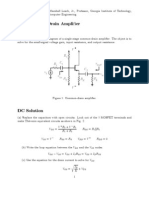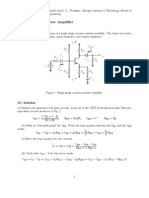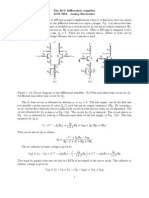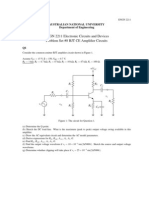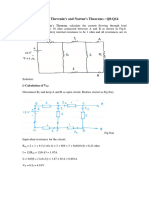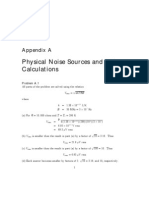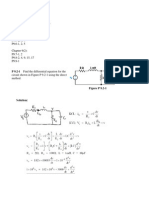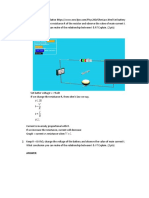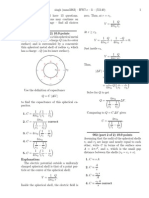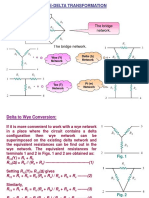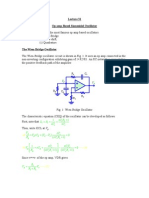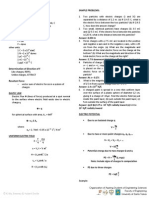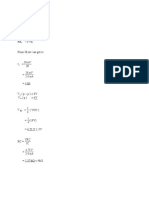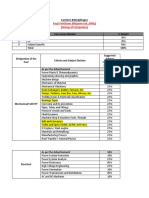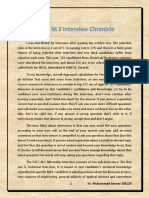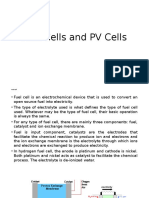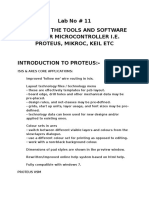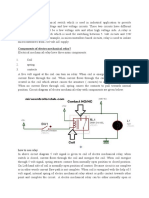Professional Documents
Culture Documents
Common Base Amplifier
Uploaded by
Mehmood Khan MarwatCopyright
Available Formats
Share this document
Did you find this document useful?
Is this content inappropriate?
Report this DocumentCopyright:
Available Formats
Common Base Amplifier
Uploaded by
Mehmood Khan MarwatCopyright:
Available Formats
The Common-Base Amplifier
Basic Circuit
Fig. 1 shows the circuit diagram of a single stage common-base amplifier. The object is to solve
for the small-signal voltage gain, input resistance, and output resistance.
Figure 1: Common-base amplifier.
DC Solution
(a) Replace the capacitors with open circuits. Look out of the 3 BJT terminals and make Thvenin
equivalent circuits as shown in Fig. 2.
VBB =
VEE = V
V + R2 + V R1
R1 + R2
RBB = R1 kR2
VCC = V +
REE = RE
RCC = RC
(b) Make an educated guess for VBE . Write the loop equation between the VBB and the VEE
nodes. To solve for IC , this equation is
VBB VEE = IB RBB + VBE + IE REE =
IC
IC
RBB + VBE +
REE
(c) Solve the loop equation for the currents.
IC = IE = IB =
VBB VEE VBE
RBB / + REE /
(d) Verify that VCB > 0 for the active mode.
VCB = VC VB = (VCC IC RCC ) (VBB IB RBB ) = VCC VBB IC (RCC RBB /)
1
Figure 2: DC bias circuit.
Small-Signal or AC Solutions
(a) Redraw the circuit with V + = V = 0 and all capacitors replaced with short circuits as shown
in Fig. 3.
Figure 3: Signal circuit.
(b) Calculate gm , r , re , and r0 from the DC solution..
gm =
IC
VT
r =
VT
IB
re =
VT
IE
r0 =
VA + VCE
IC
(c) Replace the circuits looking out of the base and emitter with Thvenin equivalent circuits
as shown in Fig. 4.
vtb = 0
Rtb = 0
vte = vs
RE
Rs + RE
Rte = Rs kRE
Figure 4: Signal circuit with Thvenin emitter circuit.
Exact Solution
(a) Replace the BJT in Fig. 4 with the Thvenin emitter circuit and the Norton collector circuit
as shown in Fig. 5.
Figure 5: Emitter and collector equivalent circuits.
(b) Solve for ic(sc) .
RE
Rs + RE
rx
+ re
re0 =
1+
ic(sc) = Gme vte = Gme vs
Gme =
(c) Solve for vo .
r0 + re0
1
Rte + re0 kr0 r0 + re0
vo = ic(sc) ric kRC kRL = Gme vs
ric =
RE
ric kRC kRL
Rs + RE
r0 + re0 kRte
1 Rte / (re0 + Rte )
3
(d) Solve for the voltage gain.
Av =
vo
RE
=
Gme ric kRC kRL
vs
Rs + RE
(e) Solve for rin .
rie = re0
rin = R1 kR2 krie
r0 + Rtc
re0 + r0 + Rtc / (1 + )
(f) Solve for rout .
rout = ric kRC
Example 1 For the CB amplifier in Fig. 1, it is given that Rs = 100 , R1 = 120 k, R2 = 100 k,
RC = 4.3 k, RE = 5.6 k, R3 = 100 , RL = 20 k, V + = 15 V, V = 15 V, VBE = 0.65 V,
= 99, = 0.99, rx = 20 , VA = 100 V and VT = 0.025 V. Solve for Av , rin , and rout .
Solution. Because the dc bias circuit is the same as for the common-emitter amplifier example,
the dc bias values, re , gm , r , and r0 are the same.
In the signal circuit, the Thvenin voltage and resistance seen looking out of the emitter are
given by
RE
vs = 0.9825vs
Rte = Rs kRE = 98.25
vte =
Rs + RE
The Thvenin resistances seen looking out of the base and the collector are
Rtb = 0
Rtc = RC kRL = 3.539 k
Next, we calculate re0 , Gme , ric , and rie .
re0 =
ric =
Rtb + rx
+ re = 12.03
1+
Gme =
r0 + re0 kRte
= 442.3 k
1 Rte / (re0 + Rte )
r0 + re0
1
1
S
=
Rte + re0 kr0 r0 + re0
111.4
rie = re0
re0
r0 + Rtc
= 12.83
+ r0 + Rtc / (1 + )
The output voltage is given by
vo = Gme (ric kRtc ) vte = Gme (ric kRtc )
RE
vs = 30.97vs
Rs + RE
Thus the voltage gain is
Av = 30.97
The input and output resistances are
rin = R1 kR2 krib = 12.81
rout = ric kRC = 4.259 k
Approximate Solutions
These solutions assume that r0 = except in calculating ric . In this case, ic(sc) = i0c = i0e = ib .
Figure 6: Simplified T model circuit.
Simplified T Model Solution
(a) After making the Thvenin equivalent circuits looking out of the base and emitter, replace the
BJT with the simplified T model as shown in Fig. 6.
(b) Solve for i0c and ric .
i0
0 vte = i0e re0 + Rte = c re0 + Rte = i0c = vte 0
re + Rte
ric =
(c) Solve for vo .
vo = i0c ric kRC kRL = vte
r0 + re0 kRte
1 Rte / (re0 + Rte )
RE
ric kRC kRL = vs
ric kRC kRL
re0 + Rte
Rs + RE re0 + Rte
(d) Solve for the voltage gain.
Av =
vo
Rs
=
ric kRC kRL
0
vs
Rs + RE re + Rte
(e) Solve for rie and rin .
0 ve = i0e re0 = i0e =
rie =
ve
re0
ve
= re0
i0e
rin = re0 kRE
(f) Solve for rout .
rout = ric kRC
Example 2 For Example 1, use the simplified T-model solutions to calculate the values of Av , rin ,
and rout .
5
Av = 0.9825 8.978 103 3.511 103 = 30.97
rin = 12
rout = 4.259 k
Model Solution
(a) After making the Thvenin equivalent circuits looking out of the base and emitter, replace the
BJT with the model as shown in Fig. 7.
Figure 7: Hybrid- model circuit.
(b) Solve for i0c and ric .
0 vte = ib rx + v + i0e Rte =
ric =
(c) Solve for vo .
vo = i0c ric kRC kRL =
i0c
i0
i0
vte
rx + c + c Rte = i0c =
1
rx
Rte
gm
+
+
gm
r0 + re0 kRte
1 Rte / (re0 + Rte )
RE
1
vte
r kR kR = vs
r kR kR
rx
r
1
1
Rte ic C L
Rte ic C L
Rs + RE x
+
+
+
+
gm
gm
(d) Solve for the voltage gain.
Av =
1
vo
RE
r kR kR
=
1
r
Rte ic C L
vs
Rs + RE x
+
+
gm
(e) Solve for rout .
rout = ric kRC
6
(f) Solve for rie and rin .
1+
i0e
(rx + r ) = i0e = ve
1+
rx + r
0 ve = ib (rx + r ) =
rie =
ve
rx + r
=
0
ie
1+
rin = rie kRE
Example 3 For Example 1, use the -model solutions to calculate the values of Av , rin , and rout .
Av = 0.9825 8.978 103 3.539 103 = 30.97
rin = 12
rout = 4.259 k
T Model Solution
(a) After making the Thvenin equivalent circuits looking out of the base and emitter, replace the
BJT with the T model as shown in Fig.??.
Figure 8: T model circuit.
(b) Solve for i0c and ric .
0 vte = ib rx + i0e (re + Rte ) =
ric =
(c) Solve for vo .
vo = i0c ric kRC kRL =
i0c
i0
vte
rx + c (re + Rte ) = i0c =
rx re + Rte
r0 + re0 kRte
1 Rte / (re0 + Rte )
RE
1
vte
r kR kR = vs
ric kRC kRL
rx re + Rte ic C L
r
r
Rs + RE x
e + Rte
+
+
(d) Solve for the voltage gain.
Av =
1
vo
RE
ric kRC kRL
=
r
r
vs
Rs + RE x
e + Rte
+
(e) Solve for rie and rin .
0 ve =
ib rx + i0e re
i0e
rx + i0e re = i0e
=
1+
rie =
rx
+ re
1+
= i0e =
ve
rx
+ re
1+
ve
rx
+ re
=
i0e
1+
rin = RE krie
(f) Solve for rout .
rout = ric kRC
Example 4 For Example 1, use the T-model solutions to calculate the values of Av , rin , and rout .
Av = 0.9825 8.978 103 3.539 103 = 30.97
rin = 12
rout = 4.259 k
You might also like
- CC Amp AnalysisDocument9 pagesCC Amp AnalysisRabee Adil JamshedNo ratings yet
- The Common-Base Amplifier Basic Circuit: BB + 2 1 1 2 BB 1 2 EE E CC + CC C BE BB EE C C BB BE C EEDocument8 pagesThe Common-Base Amplifier Basic Circuit: BB + 2 1 1 2 BB 1 2 EE E CC + CC C BE BB EE C C BB BE C EEdominggoNo ratings yet
- The Common-Emitter Amplifier: Basic CircuitDocument5 pagesThe Common-Emitter Amplifier: Basic CircuitNicolas Mora RestrepoNo ratings yet
- The Common-Collector Amplifier Basic Circuit: + 2 1 1 2 BB 1 2 EE E CC + CC C BE BB EE C BB BE C EEDocument9 pagesThe Common-Collector Amplifier Basic Circuit: + 2 1 1 2 BB 1 2 EE E CC + CC C BE BB EE C BB BE C EEdominggoNo ratings yet
- Cdamp TheveninDocument9 pagesCdamp TheveninssyellampalliNo ratings yet
- The Common-Emitter Amplifier: Basic CircuitDocument9 pagesThe Common-Emitter Amplifier: Basic Circuitmtanveer2008No ratings yet
- BJTDiff AmpDocument4 pagesBJTDiff AmpAswathi MVNo ratings yet
- Example 6-10: V R V R RDocument4 pagesExample 6-10: V R V R RmehrunisaNo ratings yet
- BJTAmplifierCircuits SolDocument9 pagesBJTAmplifierCircuits SolAristotle Atijera AnchetaNo ratings yet
- EEE1007S 2023 Tutorial Solution 5 IIDocument14 pagesEEE1007S 2023 Tutorial Solution 5 IILehlohonolo NkunaNo ratings yet
- Thev em CirDocument2 pagesThev em CirniranjanvagleNo ratings yet
- Solution Book Modern Digital and Analog Communication SystemsDocument329 pagesSolution Book Modern Digital and Analog Communication Systemsresal300050% (4)
- DC Analysis of Transistor Circuit: Calculate I, I, I Assume: 200 V 0.7 VDocument3 pagesDC Analysis of Transistor Circuit: Calculate I, I, I Assume: 200 V 0.7 Vagama1188No ratings yet
- EE2005 - Tutorial Homework Assignment 9 SolutionDocument6 pagesEE2005 - Tutorial Homework Assignment 9 SolutionKL ChiangNo ratings yet
- Phase Shift OscillatorDocument31 pagesPhase Shift OscillatorArjob MukherjeeNo ratings yet
- How To Bias Bjts For Fun and Profit: Standard BJT Biasing ConfigurationDocument12 pagesHow To Bias Bjts For Fun and Profit: Standard BJT Biasing ConfigurationskyghNo ratings yet
- EEE 241 EEE 241 Analog Electronics 1 Tutorial Tutorial DR Norlaili Mohd NohDocument42 pagesEEE 241 EEE 241 Analog Electronics 1 Tutorial Tutorial DR Norlaili Mohd NohMd Anwar HossainNo ratings yet
- Ispitni Zadaci - ElektrotehnikaDocument14 pagesIspitni Zadaci - ElektrotehnikaAleksandar KrčuljNo ratings yet
- Wye-Delta, Delta-Wye TransformationsDocument11 pagesWye-Delta, Delta-Wye TransformationsLester VirayNo ratings yet
- 5 BJT AC AnalysisDocument38 pages5 BJT AC AnalysisErikApuRaNo ratings yet
- ECE 402 - Electronic Circuit Analysis and Design CAIMDocument109 pagesECE 402 - Electronic Circuit Analysis and Design CAIMMark Niño MagdayoNo ratings yet
- Assignment 2-Bipolar Junction TransistorDocument12 pagesAssignment 2-Bipolar Junction TransistorNUR ADILA MIRHAH BINTI ISMAILNo ratings yet
- Chapter 9 Homework SolutionDocument27 pagesChapter 9 Homework Solutionjoe100% (3)
- ELE315 Exam I 2014 SolutionsDocument7 pagesELE315 Exam I 2014 SolutionsFikret LockeNo ratings yet
- Answer:: IR V R I RDocument9 pagesAnswer:: IR V R I RRizza L. MacarandanNo ratings yet
- HW7 C SolutionsDocument6 pagesHW7 C Solutionsmmsingh91No ratings yet
- SCR Sample Problem - RevDocument9 pagesSCR Sample Problem - RevDonna ComissionNo ratings yet
- EE 332 Devices and Circuits Ii Small-Signal Models and Single Transistor Amplifier (4) (CC Amplifier)Document4 pagesEE 332 Devices and Circuits Ii Small-Signal Models and Single Transistor Amplifier (4) (CC Amplifier)Mạnh Cường TrầnNo ratings yet
- EE-111 Lecture Notes No.Document10 pagesEE-111 Lecture Notes No.dummyNo ratings yet
- Rland RCDocument33 pagesRland RCSyed Muhammad DanishNo ratings yet
- Fig-1 in (Lec - 05 - Ver - 01.vsd) : Common Emitter Amplifier Frequency ResponseDocument16 pagesFig-1 in (Lec - 05 - Ver - 01.vsd) : Common Emitter Amplifier Frequency ResponsedileepdnNo ratings yet
- Tutorial 5 - AnswerDocument5 pagesTutorial 5 - Answerእኛ ከሌለን ባዶNo ratings yet
- Chap13 Exercise SolutionDocument9 pagesChap13 Exercise SolutionAnonymous pcanQ3No ratings yet
- Wein Bridge Oscillators PresentationDocument15 pagesWein Bridge Oscillators PresentationHarish KumarNo ratings yet
- BJT Formulae SheetsDocument1 pageBJT Formulae SheetsGaurav Shrimali0% (1)
- 3054 PDFDocument9 pages3054 PDFpadmajasivaNo ratings yet
- 2013 Lect 04 RCL CircuitsDocument2 pages2013 Lect 04 RCL CircuitsoxnerdkiNo ratings yet
- EE 42/43/100 Introduction To Digital Electronics: Review of Ch. 4-7.3 7/19/13Document43 pagesEE 42/43/100 Introduction To Digital Electronics: Review of Ch. 4-7.3 7/19/13ozanistzNo ratings yet
- RC Phase Shift Oscillator Full DerivationDocument12 pagesRC Phase Shift Oscillator Full DerivationPranav Itraj0% (1)
- EEE1007S 2023 Tutorial Solution 5Document11 pagesEEE1007S 2023 Tutorial Solution 5Lehlohonolo NkunaNo ratings yet
- BJT T ModelDocument9 pagesBJT T Modelkashyap_cherukuriNo ratings yet
- Electrotechnics 1b Outcome B Test 1 Memo 2021Document7 pagesElectrotechnics 1b Outcome B Test 1 Memo 2021spm0826722No ratings yet
- Analysis of BJT CircuitsDocument14 pagesAnalysis of BJT CircuitsPrasitNo ratings yet
- Files-3-Lesson Notes Lecture 31Document8 pagesFiles-3-Lesson Notes Lecture 31Eyad Abozyd100% (1)
- Physics II Finals ReviewerDocument6 pagesPhysics II Finals ReviewerCarter SiyNo ratings yet
- Oscillator DesignDocument10 pagesOscillator Designsowmya.mas1542No ratings yet
- V I I IE: Calculation We Assume 19V 2.0maDocument4 pagesV I I IE: Calculation We Assume 19V 2.0malovatalialNo ratings yet
- Strain: X A B C SDocument9 pagesStrain: X A B C SJuan Camilo Guarnizo BermudezNo ratings yet
- Soln AE09Document48 pagesSoln AE09Santosh Kumar SharmaNo ratings yet
- Electrical and Electronic Technology (BEX17003) : DR Soon Chin FhongDocument58 pagesElectrical and Electronic Technology (BEX17003) : DR Soon Chin FhongThiran Boy LingamNo ratings yet
- 2020 FinalDocument3 pages2020 FinalBen ChouNo ratings yet
- Physics SectionDocument18 pagesPhysics SectionMahmoud Abdel-SalamNo ratings yet
- Electrical and Electronic Principles 3 Checkbook: The Checkbook SeriesFrom EverandElectrical and Electronic Principles 3 Checkbook: The Checkbook SeriesNo ratings yet
- 110 Waveform Generator Projects for the Home ConstructorFrom Everand110 Waveform Generator Projects for the Home ConstructorRating: 4 out of 5 stars4/5 (1)
- Electronics 3 Checkbook: The Checkbooks SeriesFrom EverandElectronics 3 Checkbook: The Checkbooks SeriesRating: 5 out of 5 stars5/5 (1)
- Help Us Understand You Better, Your Feedback Is Very Important To Us. Please Complete This FormDocument1 pageHelp Us Understand You Better, Your Feedback Is Very Important To Us. Please Complete This FormMehmood Khan MarwatNo ratings yet
- Lisezmoi OSSDocument26 pagesLisezmoi OSSMehmood Khan MarwatNo ratings yet
- HSE-097 Work at Height Risk RegisterDocument2 pagesHSE-097 Work at Height Risk RegisterMehmood Khan MarwatNo ratings yet
- 12.1. Electrical Safety ProgramDocument9 pages12.1. Electrical Safety ProgramMehmood Khan MarwatNo ratings yet
- FFBL CW PDFDocument5 pagesFFBL CW PDFSyed Anas SohailNo ratings yet
- Lisezmoi OSSDocument26 pagesLisezmoi OSSMehmood Khan MarwatNo ratings yet
- Bottle WasherDocument18 pagesBottle WasherMehmood Khan MarwatNo ratings yet
- GencoDocument3 pagesGencoSaad AhsanNo ratings yet
- Introduction To Load FlowDocument9 pagesIntroduction To Load Flowmaross_1950No ratings yet
- Paper No.4 Analytical: If Hank Joins The Group, and If He Is Shorter Than Gina, Then Which of The Following MUST Be TrueDocument15 pagesPaper No.4 Analytical: If Hank Joins The Group, and If He Is Shorter Than Gina, Then Which of The Following MUST Be TrueHAFIZ IMRAN AKHTERNo ratings yet
- PresentationDocument17 pagesPresentationMehmood Khan MarwatNo ratings yet
- Hidden Active Cell Phone DetectorDocument15 pagesHidden Active Cell Phone DetectorMehmood Khan MarwatNo ratings yet
- PIEAS M.S Fellowship InterviewDocument9 pagesPIEAS M.S Fellowship InterviewEngr Muhammad Yaar Saqib100% (2)
- Homework Solution1Document2 pagesHomework Solution1Hari PrasadNo ratings yet
- p203 PDFDocument7 pagesp203 PDFMehmood Khan MarwatNo ratings yet
- p203 PDFDocument7 pagesp203 PDFMehmood Khan MarwatNo ratings yet
- Manual 120726 Blow Moulding PDFDocument31 pagesManual 120726 Blow Moulding PDFrize1159No ratings yet
- Electric Servomotor As A Governor For A Micro Hydro Power PlantDocument1 pageElectric Servomotor As A Governor For A Micro Hydro Power PlantMehmood Khan MarwatNo ratings yet
- GraphDocument1 pageGraphMehmood Khan MarwatNo ratings yet
- How To Solve Blow Molding ProblemsDocument12 pagesHow To Solve Blow Molding ProblemsOmar EstradaNo ratings yet
- Fuel Cells and PV CellsDocument22 pagesFuel Cells and PV CellsMehmood Khan MarwatNo ratings yet
- p203 PDFDocument7 pagesp203 PDFMehmood Khan MarwatNo ratings yet
- PSS Final PDFDocument2 pagesPSS Final PDFMehmood Khan MarwatNo ratings yet
- 11 22Document36 pages11 22Mehmood Khan MarwatNo ratings yet
- 1 Vacancy AnnouncementDocument5 pages1 Vacancy AnnouncementMehmood Khan MarwatNo ratings yet
- Energy Recovery From Water Supply TankDocument5 pagesEnergy Recovery From Water Supply TankMehmood Khan MarwatNo ratings yet
- Arduino Nano Manual 23Document5 pagesArduino Nano Manual 23Arthur de AbreuNo ratings yet
- EulaDocument11 pagesEulaMat DenialNo ratings yet
- Cyber Security in Smart GridsDocument12 pagesCyber Security in Smart GridsMehmood Khan MarwatNo ratings yet
- Communication Smart GridsDocument4 pagesCommunication Smart GridsJoe MullerNo ratings yet




